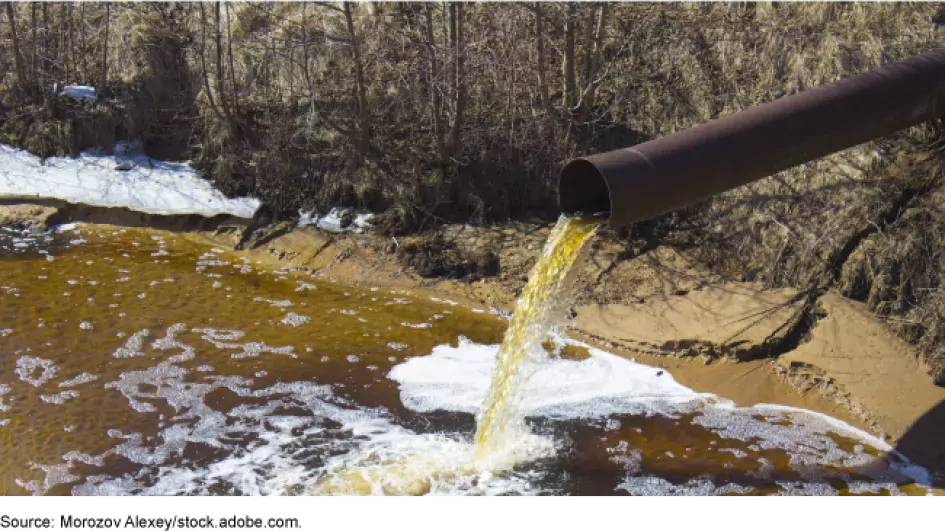Thousands of Discharges Keep Pollution Flowing: How can EPA better protect Our Nation’s Waters?
The Environmental Protection Agency (EPA) leads federal efforts to monitor water quality in the nation’s lakes, rivers, streams, and other water bodies. However, in 2018, EPA estimated that nearly 11,000 industrial facilities and municipal wastewater treatment plants had illegally dumped significant amounts of pollution into nearby water bodies.
For World Water Day—a day meant to raise awareness of the importance of clean water access—today’s WatchBlog post looks at EPA’s efforts to monitor and reduce water pollution, and our recommendations for improving this oversight.
Image

How does EPA track water pollution?
Under the Clean Water Act, municipal wastewater treatment plants and industrial facilities must obtain a permit from EPA—or authorized state, tribal, and territorial governments—to discharge pollutants, such as contaminated wastewater, into waters of the U.S.
In FY 2020, about 335,000 facilities had such permits, including more than 700 municipalities with sewer systems that have combined sewer overflows, which can be a major source of pollution during heavy rainfall events. These permits set limits on the amount of pollutants allowed from each source and protect designated uses of the receiving waters. In addition, many facilities are required to monitor and report the amount of pollutants discharged each year to EPA. However, as discussed above, in 2018, nearly 11,000 facilities significantly exceeded their permit limits and illegally discharged pollutants into nearby waters.
In addition, hundreds of municipalities across the U.S. have combined sewer systems—sewer systems that combine sewage and stormwater in one set of pipes rather than two separate pipelines. These systems can discharge untreated sewage into a nearby water bodies during heavy rainfall or snowmelt.
Because of the mixture of bacteria, solids, toxic chemicals, and other pollutants that can be contained in these discharges, they pose serious threats to public health and water quality.
What steps has EPA taken to improve monitoring and reduce illegal water pollution?
EPA has set a goal to reduce significant noncompliance with permits by the end of FY 2022.
As part of an effort to make its data more accurate and complete, in 2015, EPA began requiring states and facilities to electronically report data on their activities. EPA posts data on compliance and enforcement activities to its website.
However, we found that EPA does not know if the data reported by states and facilities are complete and accurate, which could undermine its efforts to track progress toward its goal. For example, EPA's most recent assessment of states' data, which are done on a 5-year rotating basis, showed that two of 17 states met EPA’s expectations for the accuracy and completeness of the data recorded in the agency's national database. We also found that while EPA is working with states to improve the quality of data reported by facilities, it did not have a plan to assess the overall accuracy of the data.
In addition, we found that EPA does not track whether enforcing compliance with permits has reduced the amount of pollutants discharged into bodies of water. EPA tracks the rates of compliance by permit holders, but does not track the overall effect of improved compliance on water quality.
How could EPA improve its efforts?
To help improve our nation’s water quality and help EPA’s enforcement efforts, we recommended that EPA improve the quality of data it collects and reports to the public on its website. This would help EPA track illegal and harmful pollutant discharges into water sources and help it monitor progress toward its goal of reducing permits in noncompliance.
Find out more about our work on water quality and protection here.
- Comments on GAO’s WatchBlog? Contact blog@gao.gov.
GAO Contacts
Related Products

GAO's mission is to provide Congress with fact-based, nonpartisan information that can help improve federal government performance and ensure accountability for the benefit of the American people. GAO launched its WatchBlog in January, 2014, as part of its continuing effort to reach its audiences—Congress and the American people—where they are currently looking for information.
The blog format allows GAO to provide a little more context about its work than it can offer on its other social media platforms. Posts will tie GAO work to current events and the news; show how GAO’s work is affecting agencies or legislation; highlight reports, testimonies, and issue areas where GAO does work; and provide information about GAO itself, among other things.
Please send any feedback on GAO's WatchBlog to blog@gao.gov.




